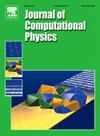Accelerating eigenvalue computation for nuclear structure calculations via perturbative corrections
IF 3.8
2区 物理与天体物理
Q2 COMPUTER SCIENCE, INTERDISCIPLINARY APPLICATIONS
引用次数: 0
Abstract
Subspace projection methods utilizing perturbative corrections have been proposed for computing the lowest few eigenvalues and corresponding eigenvectors of large Hamiltonian matrices. In this paper, we build upon these methods and introduce the term Subspace Projection with Perturbative Corrections (SPPC) method to refer to this approach. We tailor the SPPC for nuclear many-body Hamiltonians represented in a truncated configuration interaction subspace, i.e., the no-core shell model (NCSM). We use the hierarchical structure of the NCSM Hamiltonian to partition the Hamiltonian as the sum of two matrices. The first matrix corresponds to the Hamiltonian represented in a small configuration space, whereas the second is viewed as the perturbation to the first matrix. Eigenvalues and eigenvectors of the first matrix can be computed efficiently. Because of the split, perturbative corrections to the eigenvectors of the first matrix can be obtained efficiently from the solutions of a sequence of linear systems of equations defined in the small configuration space. These correction vectors can be combined with the approximate eigenvectors of the first matrix to construct a subspace from which more accurate approximations of the desired eigenpairs can be obtained. We show by numerical examples that the SPPC method can be more efficient than conventional iterative methods for solving large-scale eigenvalue problems such as the Lanczos, block Lanczos and the locally optimal block preconditioned conjugate gradient (LOBPCG) method. The method can also be combined with other methods to avoid convergence stagnation.
通过微扰修正加速核结构计算的特征值计算
利用微扰修正的子空间投影方法计算了大哈密顿矩阵的最小特征值和相应的特征向量。在本文中,我们在这些方法的基础上,引入了带有微扰修正的子空间投影(SPPC)方法来指代这种方法。我们针对截断组态相互作用子空间中的核多体哈密顿量,即无核壳模型(NCSM),对SPPC进行了调整。我们利用NCSM哈密顿的层次结构将哈密顿划分为两个矩阵的和。第一个矩阵对应于在一个小位形空间中表示的哈密顿量,而第二个矩阵被看作是对第一个矩阵的扰动。可以有效地计算第一个矩阵的特征值和特征向量。由于这种分裂,可以有效地从小位形空间中定义的一系列线性方程组的解中获得对第一个矩阵特征向量的微扰修正。这些校正向量可以与第一个矩阵的近似特征向量组合以构造一个子空间,从中可以获得所需特征对的更精确的近似值。通过数值算例表明,SPPC方法可以比传统的迭代方法更有效地解决大规模特征值问题,如Lanczos、块Lanczos和局部最优块预条件共轭梯度(LOBPCG)方法。该方法也可以与其他方法相结合,避免收敛停滞。
本文章由计算机程序翻译,如有差异,请以英文原文为准。
求助全文
约1分钟内获得全文
求助全文
来源期刊

Journal of Computational Physics
物理-计算机:跨学科应用
CiteScore
7.60
自引率
14.60%
发文量
763
审稿时长
5.8 months
期刊介绍:
Journal of Computational Physics thoroughly treats the computational aspects of physical problems, presenting techniques for the numerical solution of mathematical equations arising in all areas of physics. The journal seeks to emphasize methods that cross disciplinary boundaries.
The Journal of Computational Physics also publishes short notes of 4 pages or less (including figures, tables, and references but excluding title pages). Letters to the Editor commenting on articles already published in this Journal will also be considered. Neither notes nor letters should have an abstract.
 求助内容:
求助内容: 应助结果提醒方式:
应助结果提醒方式:


